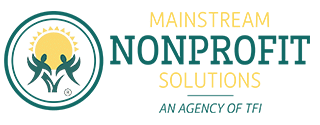Every charity faces risks, some of which can severely damage your organization’s reputation and financial stability. At Mainstream Nonprofit Solutions, we want to help you avoid these risks and protect the future of your charitable organization by offering risk management services. We understand that no two charities are the same, so we offer customized risk management strategies and policies that align with your mission, vision, organizational culture, and values.
Learn more about our risk management services at our website or by contacting us today!

What Is Risk Management?
Risk management is identifying, assessing, and controlling risks to an organization. It includes actions taken to minimize or eliminate the negative impact of risks. Good risk management can help an organization achieve its goals and objectives, while bad risk management can lead to financial losses, legal liabilities, and reputational damage.
Many types of risks could affect charitable organizations, including operational, technology, security, human resources, strategic, and environmental risks. There are various ways to address these risks, including insurance policies, vendor contracts, access controls on computers and buildings (e.g., locks), etc.
Why Do You Need It?
As a charitable organization, you are likely to face various risks every day. Risk management is identifying, assessing, and controlling these risks. Implementing risk management strategies protects your organization from potential financial losses, legal liabilities, and reputational damage.
For example, if an employee discloses confidential information to an outsider who misuses it, this would be considered a breach of confidentiality. In addition, you may want to consider purchasing cyber insurance or updating your security systems so that future breaches are less likely.
Risk management is crucial for nonprofit organizations because they rely heavily on contributions and public funding to provide services. They have minimal funds set aside as reserves, making them more vulnerable than other types of organizations when disaster strikes or funding decreases dramatically.
The Foundations of Risk Management
The main goals of risk management are to protect your organization’s people, property, and reputation and minimize the risks’ negative impact on your business.
Risk management involves three critical steps: identification, assessment, and control. The first step is to identify possible risks that could negatively affect your organization. Then, once you have identified potential threats, you must assess their likelihood and severity.
Finally, you need to decide how best to control the risk if it happens by taking a preventative measure or having a plan in place.
Identifying Risks and Building a Plan to Manage Them
As a charitable organization, you are likely already aware of the many risks that come with the territory. But did you know that there are steps you can take to manage these risks proactively? By identifying potential risks and putting a plan in place to mitigate them, you can help protect your organization from future challenges. Managing risks does not have to be overwhelming, though. There are several resources available to help guide you through this process.
For example, the American Institute of Certified Public Accountants has created a Risk Management Toolkit that offers guidance on what risk management entails as well as tools to get started on implementing it within your organization.
You may also want to consult with other nonprofit leaders in your community who have already experienced similar issues or used risk management strategies. They may be able to offer additional insight into which risks are most important for you to address first.
Knowing Your Organization Inside Out
Before you can manage risk, you must understand what could go wrong and why. That’s why it’s essential to know your organization inside and out. What are its strengths and weaknesses? What are the potential risks?
Once you understand these things well, you can start putting together a plan to manage risk. Many resources can help you get started. One is the Risk Checklist for Nonprofits (RCN). RCN is an online tool that helps you identify where your nonprofit may be vulnerable to financial loss and provides guidance on how to address those vulnerabilities.
Another resource is the National Council of Nonprofits’ Protecting Your Organization from Fraud series, which provides comprehensive information about preventing fraud in all aspects of nonprofit management, including fraud prevention policies, training employees and volunteers, fundraising policies, vendor selection practices, donor relations practices, and more.
In addition to this valuable content, NCN also offers legal services through its partnership with Volunteer Legal Services Corporation (VLSC) to provide pro bono legal services for nonprofits throughout the country. These materials will help you understand your organization’s risks so you can make informed decisions about how best to protect them.
Tips for Managing Specific Risks
As a charitable organization, you are likely to face various risks. Here are some tips for managing specific risks
- Determine your risk tolerance: Risk tolerance is the degree to which an individual or organization can tolerate risk. In other words, it is how much risk they are willing to take on to achieve the goals they have set out for themselves.
- Make sure your insurance covers everything: Ensure that your insurance covers all potential hazards, both natural and artificial. It is vital that the coverage offered matches your needs and does not leave any areas uncovered in case something happens. -Be aware of disaster relief options: Disaster relief programs may be available to help with repairs following disasters such as earthquakes, hurricanes, floods, and more.
- Build relationships with others in the community: One way to reduce exposure to financial loss is by building relationships with others who might share your needs should a disaster strike their area. For example, you can join local organizations like chambers of commerce, rotary clubs, or volunteer fire departments. Joining these organizations will put you in contact with people who live near you and could potentially offer assistance during times of need.
Contact Us
Mainstream Nonprofit Solutions is a 501(c)(3) organization that provides risk management services to charitable organizations in Kansas, Nebraska, Oklahoma, Texas, and Washington. We have a team of experienced professionals who can help you identify and manage risks associated with your organization.
Contact us today to learn more about our services or to request a free consultation.

